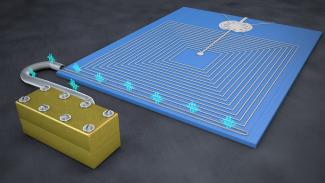Quantum computers require systems that can encode, manipulate, and transmit quantum bits, or qubits. A creative way to accomplish all this was recently demonstrated by Adam Reed and his colleagues in the Lehnert group. The researchers converted propagating qubits (encoded as superpositions1 of zero and one microwave photons) into the motion of a tiny aluminum drum. The successful conversion is considered a key step in using a mechanical drum to (1) transfer quantum information between microwave and optical frequencies or (2) store quantum information inside a quantum computer.
“We wanted to ask whether these electromechanical devices could manipulate fragile signals that encode quantum information,” Reed explained. “We’re trying to determine how suitable this device is for quantum information applications.”
And the answer is: The Lehnert group is getting there. When the researchers measure how the state encoded in the drum’s motion compares with the original propagating qubits, they find that the fidelity is about 80% for any qubit state they convert, which is not too bad for a brand new kind of device.
One long-range goal of this project is to use the mechanical drums as converters of information that link between microwaves and visible light. These converters will play a key role in future quantum networks, which will have vastly increased bandwidth and security. These networks will rely on optical signals transmitted over fibers between nodes storing and processing information with microwave (electrical) signals. And, they will require perfect and flexible conversion between optical qubits and microwave (electrical) qubits. Reed and his colleagues’ work is helping to build the technology for these future quantum networks.
“It’s not so far out to believe you can take a quantum state generated by a superconducting qubit and convert it to motion, then build a system that completes the transfer to light,” Reed said.
Reed and his colleagues’ result is the very, very first step in showing that it’s possible to take a quantum signal, encode it in an electronic pulse, then convert that pulse to mechanical motion. The final step will be converting the mechanical motion to optical photons. Every step in this process has been sufficiently challenging to require years to complete. That’s why the new result is so exciting
“For the first time, we were able to take our electromechanical devices and use them to process qubits, and we do that all in the microwave domain,” Reed said. “This accomplishment may lead to offshoots in many directions for building quantum networks that could potentially interface with light.”––Julie Phillips
1In the quantum world, any two (or more) quantum states can be added together ("superposed"), and the result will be a third quantum state.




